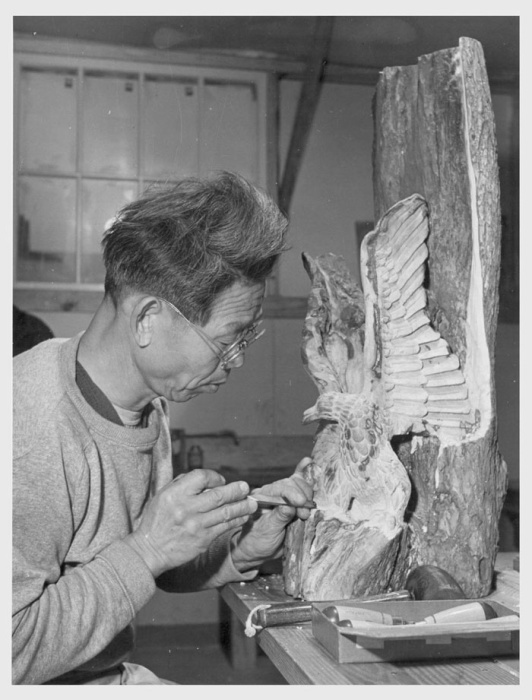April 17, 2015
*The following material has been excerpted from the Densho Encyclopedia; visit the full entry to learn more.

Beauty Behind Barbed Wire: The Arts of the Japanese in Our War Relocation Camps is a book by folk art expert Allen H. Eaton that was published by Harper & Brothers in 1952. The lavishly illustrated book was the first to examine the arts and crafts produced by incarcerated Japanese Americans—and one of the first books to examine any aspect of inmate life in the concentration camps. The foreword to the book was written by Eleanor Roosevelt, a friend of the author’s.
Known as the “dean of American crafts” and “acknowledged authority on the crafts of various ethnic groups in the United States,” Eaton began working for the Russell Sage Foundation, one of the country’s largest charitable foundations in 1920, where he would remain for the next 26 years. While there, he established himself as an expert on immigrant life and folk arts, mounting pioneering exhibitions and authoring landmark books including Immigrants Gifts to American Life (1932) and Handicrafts of the Southern Highlands (1937). In 1937, he also worked on the Rural Arts Exhibition in Washington, DC for the Department of Agriculture, which led to his becoming a friend and correspondent of Eleanor Roosevelt.
With the incarceration of West Coast Japanese Americans in concentration camps during World War II, Eaton approached Dillon Myer, director of the War Relocation Authority (WRA), the agency in charge of administering the camps, about the possibility of documenting the arts and crafts of the inmates and of putting together an exhibition of American ethnic handicrafts that might tour the camps. Though not unsympathetic, Myer declined WRA funding of Eaton’s project, inviting him to seek other funders. The Sage Foundation also declined to fund the project, perhaps due in part to Eaton’s being near retirement age by that time. Still intrigued by the possibilities of the Japanese American project, he took a vacation in 1945 and visited five of the camps, identifying objects and photographers at those camps. He also found photographers and curatorial assistants at the other four camps to do the same. The photographers included WRA photographers such as Tom Parker, inmate photographers including Toyo Miyatake (who in addition to taking photographs at Manzanar, was dispatched to Poston and Gila River), and local professionals from the area near specific camps.
Eaton had in the meantime secured funding for the project from the Rockefeller Foundation, through the sponsorship of the Society of Japanese Studies, along with the Japan Society. Delayed from finishing the book due to work on other projects—his New England handicrafts book was published in 1949 and he went to Europe in 1950 as part of the Economic Co-operation Administration of the Marshall Plan—he finished the manuscript in 1951. Harper & Brothers, which had published his New England book, agreed to publish the Japanese American book once the Japan Society committed to buying enough copies of it. Beauty Behind Barbed Wire was published on the 10th anniversary of Executive Order 9066, on February 19, 1952. Eaton was 73 years old by the time the book came out.[2]A second edition of the book appeared in 1955, with a new three-page postscript that adds information on the Evacuation Claims Act and the Immigration Act of 1952.[3]
The core of the 208 page book is made up of 81 sets of photographs on odd numbered pages accompanied by Eaton’s explanatory text on the facing even numbered page. The photograph pages—most consist of one large photograph, while others are sets of two or more related images—depict a wide range of creative expression from the WRA camps, ranging from gardens and other external and internal modifications of barrack living spaces to handicrafts, painting and sculpture and a few images of Japanese cultural activity such as bon dance or tea ceremony. Many of the images include camp inmates, whether artists at work, students in art classes, or people enjoying art displays. Eaton’s accompanying text, which ranges in length from just a couple of paragraphs to a full page, generally provides the camp specific context of the depicted work along with his own observations, often drawing on and quoting from works on Japanese art and culture.
Read more about Beauty Behind Bars in the Densho Encyclopedia.
